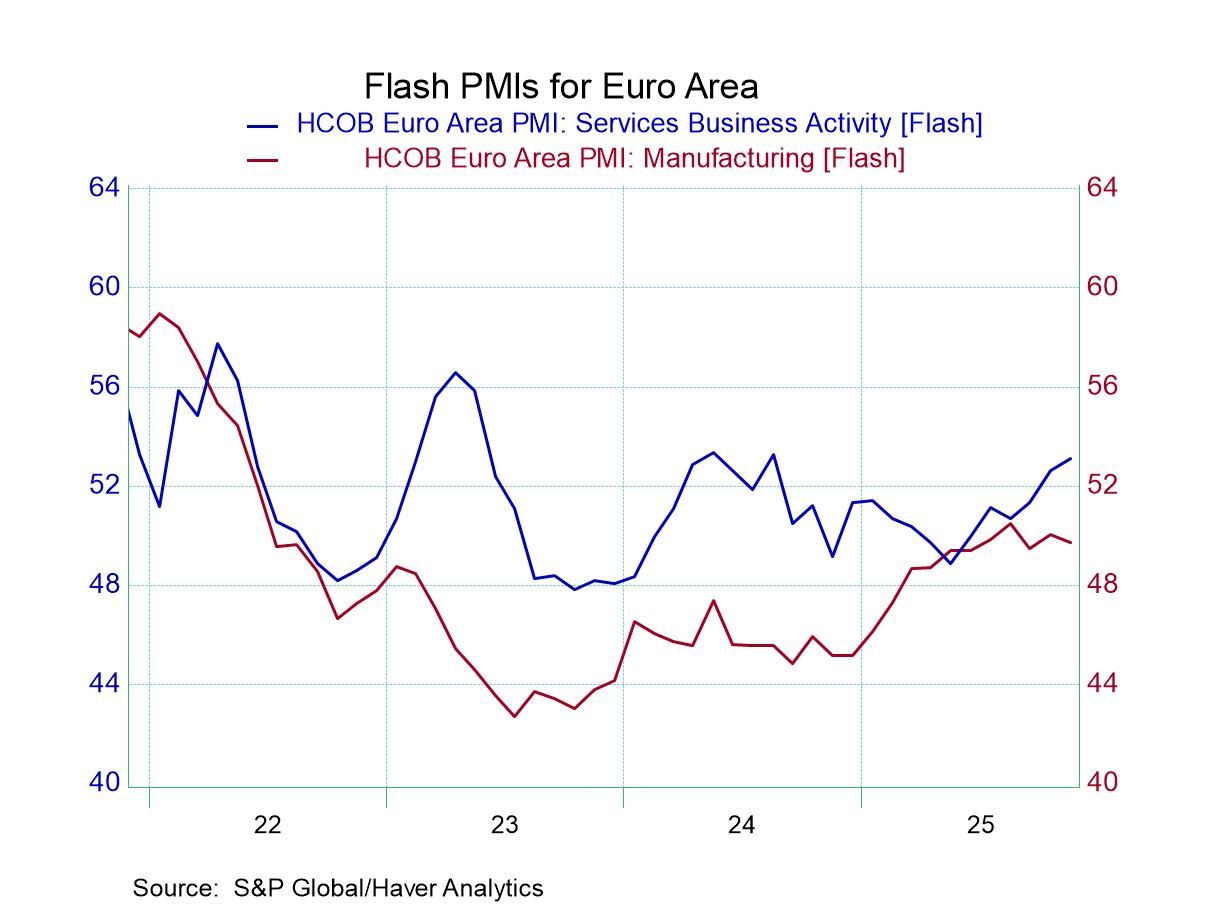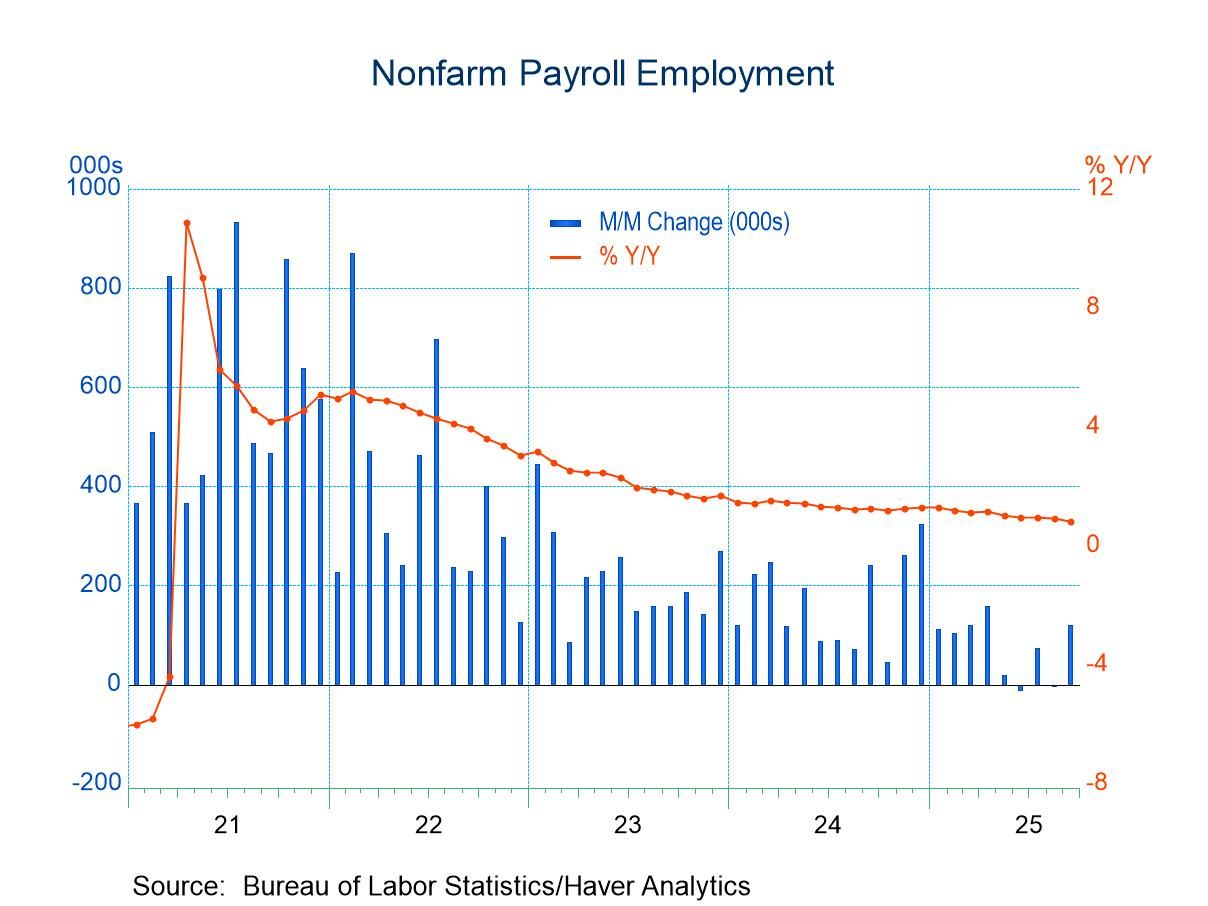 Global| Jul 28 2006
Global| Jul 28 2006Japan Labor Data Ease in June, But Conditions Remain Positive
Summary
Japanese stocks rose and bonds fell after a plethora of economic data that traders deemed favorable today. June consumer prices showed an eighth straight month of year-on-year increase in the most popular measure, the total less fresh [...]
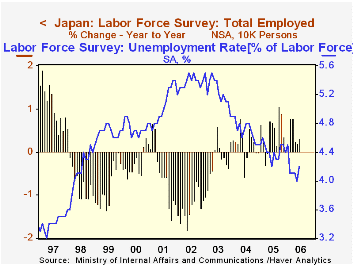
Japanese stocks rose and bonds fell after a plethora of economic data that traders deemed favorable today. June consumer prices showed an eighth straight month of year-on-year increase in the most popular measure, the total less fresh food, which was up 0.6%. Retail sales rose 0.4% from a year ago. The labor market, which we feature here, moderated somewhat, but perhaps analysts saw this as a pause in an otherwise increasingly robust picture.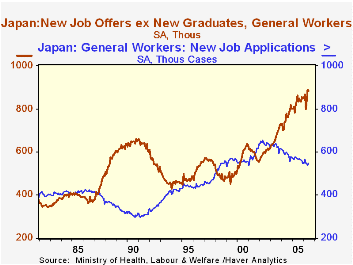
Employment fell 160,000 after advancing 270,000 in May. However, the June figure was up 0.3% from a year ago, a bit more growth than the 0.2% of May and April. The unemployment rate rose to 4.2% from May's 4.0%. The latter rate was the lowest in a little over eight years.
One of the Japanese news services, Mainichi, called our attention to the set of interesting data on job openings and placements from the Ministry of Health, Labor and Welfare. [The aggregate labor force survey is published by the Ministry of Internal Affairs and Communications.] In June, the number of people registered as needing work was 2.15 million, the smallest since late 1997; during the recent long period of economic stress in Japan, this number peaked at 2.805 million in January 2002. The other side of this coin is job openings, which totaled 2.327 million in June, compared with a cycle low of 1.174 million in May 1999. The number of openings was smaller than the number of applicants until just this past December.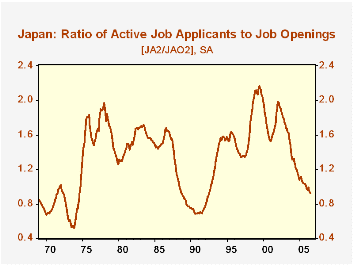
The ratio of these "active" openings to "active" applicants was 1.08 in June, suggesting that conditions are positive for employment to continue growing. Remarkably, this is the highest such value since July 1992, almost 14 years. At its worst, the relationship between applicants and openings saw at least 2 applicants for every opening; this prevailed from autumn 1998 throughout 1999. Presently, additional data on marginal changes in the labor market show how much conditions have changed: new job openings are far larger than the number of new job applicants. Their June ratio was 1.62, following May's 1.65. The last time this indicator of marginal changes in labor market conditions was this high was May of 1992. Its low was 0.80, also in May 1999.
| Japan: SA | June 2006 | May 2006 | Apr 2006 | June 2005 | 2005 | 2004 | 2003 |
|---|---|---|---|---|---|---|---|
| Employment (millions) | 63.75 | 63.91 | 63.64 | 63.55 | 63.57 | 63.29 | 63.15 |
| Change (thous.) / Yr-to-Yr % Change* | -160 | +270 | -50 | 0.3% | 0.4% | 0.2% | -0.2% |
| Unemployment Rate (%) | 4.2% | 4.0% | 4.1% | 4.2% | 4.4% | 4.7% | 5.3% |
| Active Applications (thous.) | 2,150 | 2,156 | 2,181 | 2,294 | 2,272 | 2,367 | 2,595 |
| New Applications (thous.) | 547 | 538 | 545 | 570 | 567 | 589 | 626 |
| Active Openings (thous.) | 2,327 | 2,309 | 2,266 | 2,191 | 2,167 | 1,958 | 1,672 |
| New Openings (thous.) | 884 | 889 | 839 | 863 | 831 | 761 | 673 |
| Ratio: Active Openings to Applications | 1.08 | 1.07 | 1.04 | 0.96 | 0.95 | 0.83 | 0.64 |
| Ratio: New Openings to Applications | 1.62 | 1.65 | 1.54 | 1.51 | 1.47 | 1.29 | 1.08 |
Carol Stone, CBE
AuthorMore in Author Profile »Carol Stone, CBE came to Haver Analytics in 2003 following more than 35 years as a financial market economist at major Wall Street financial institutions, most especially Merrill Lynch and Nomura Securities. She had broad experience in analysis and forecasting of flow-of-funds accounts, the federal budget and Federal Reserve operations. At Nomura Securities, among other duties, she developed various indicator forecasting tools and edited a daily global publication produced in London and New York for readers in Tokyo. At Haver Analytics, Carol was a member of the Research Department, aiding database managers with research and documentation efforts, as well as posting commentary on select economic reports. In addition, she conducted Ways-of-the-World, a blog on economic issues for an Episcopal-Church-affiliated website, The Geranium Farm. During her career, Carol served as an officer of the Money Marketeers and the Downtown Economists Club. She had a PhD from NYU's Stern School of Business. She lived in Brooklyn, New York, and had a weekend home on Long Island.



